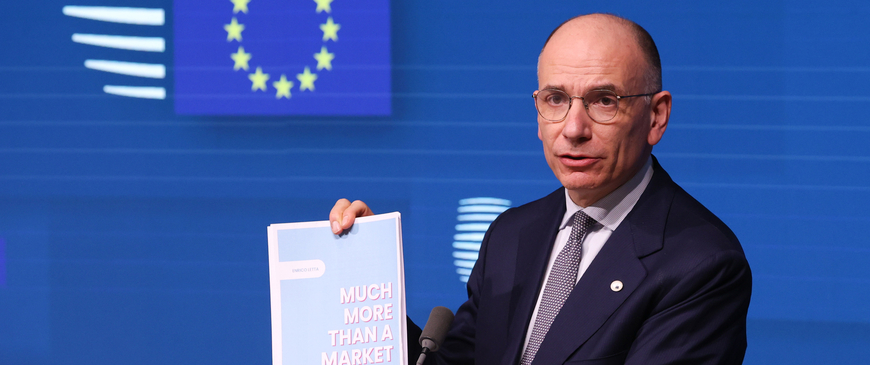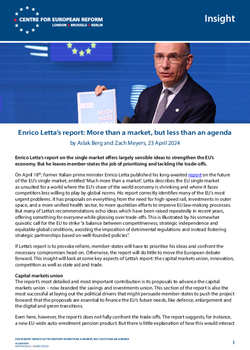
Enrico Letta's report: More than a market, but less than an agenda
Enrico Letta’s report on the single market offers largely sensible ideas to strengthen the EU’s economy. But he leaves member-states the job of prioritising and tackling the trade-offs.
On April 18th, former Italian prime minister Enrico Letta published his long-awaited report on the future of the EU’s single market, entitled ‘Much more than a market’. Letta describes the EU single market as unsuited for a world where the EU’s share of the world economy is shrinking and where it faces competitors less willing to play by global norms. His report correctly identifies many of the EU’s most urgent problems. It has proposals on everything from the need for high-speed rail, investments in outer space, and a more unified health sector, to more quotidian efforts to improve EU law-making processes. But many of Letta’s recommendations echo ideas which have been raised repeatedly in recent years, offering something for everyone while glossing over trade-offs. This is illustrated by his somewhat quixotic call for the EU to strike “a balance between competitiveness, strategic independence and equitable global conditions, avoiding the imposition of detrimental regulations and instead fostering strategic partnerships based on well-founded policies”.
If Letta’s report is to provoke reform, member-states will have to prioritise his ideas and confront the necessary compromises head-on. Otherwise, the report will do little to move the European debate forward. This insight will look at some key aspects of Letta’s report: the capital markets union, innovation, competition as well as state aid and trade.
Capital markets union
The report’s most detailed and most important contribution is its proposals to advance the capital markets union – now branded the savings and investments union. This section of the report is also the most successful at laying out the political drivers that might persuade member-states to push the project forward: that the proposals are essential to finance the EU’s future needs, like defence, enlargement and the digital and green transitions.
Even here, however, the report’s does not fully confront the trade-offs. The report suggests, for instance, a new EU-wide auto-enrolment pension product. But there is little explanation of how this would interact with existing national pension arrangements or how it would improve firms’ access to capital across Europe. Nor is it clear whether Europe needs to encourage more savings at all. When, as the report laments, European savings flow to America that is a natural consequence of Europe’s position as a net saver with a large trade surplus and the US position as a net consumer with a deficit. Reversing this would require encouraging consumption, not savings.
The lack of detail has made it easier for many member-states to adopt their usual objections. Some countries fear being disadvantaged by increased harmonisation, in particular Ireland, Luxembourg and the Netherlands which have relatively strong capital markets for their size. These countries would benefit from integration because financial services tend to agglomerate in regions that already have an edge, but their resistance is probably driven by jitters that harmonisation would lead to them losing revenue from their aggressive tax rates. Similarly, the proposal to strengthen European-level supervision of financial markets through the European Securities and Markets Authority is welcome, but there is little new in the report to convince countries which oppose common supervision to change their minds.
The report also pushes some proposals which are sensible but would not achieve the report’s ambitions. The EU would benefit from a common European safe asset, for example. But the report recommends homogenising EU debt – so that bonds issued by the European Commission, European Investment Bank (EIB) and European Stability Mechanism (ESM) are not differentiated in the market and instead marketed as one product. Even under the most optimistic of assumptions, however, this would not become “the main instrument of reference” for the European Central Bank. The volume and liquidity of EU debt would still be far less than that of the larger member states: the EU has currently issued €500 billion of debt (more if EIB and ESM debt are included), largely under the Next Generation EU programme, while France alone has issued more than €3 trillion. Although EU debt is set to rise over the next years, it seems unlikely to compete with national debts as a benchmark in the short to medium term, especially as any further debt issuance would be politically difficult to achieve.
Elsewhere in the report, Letta suggests the creation of a European Business Code that would function as a 28th regime to give firms an alternative to complying with existing national codes and allow for quicker Europeanisation. This is an ambitious proposal that could alleviate the bureaucratic burden of navigating different legal regimes in different member-states. Applying this logic to the financial sector could be one alternative to contentious harmonisation. It would allow countries to retain their own national codes while providing an attractive European-level alternative which firms could choose to adopt instead – and reduce legal complexity for capital market investors in EU firms.
Despite its weaknesses, the Letta report’s emphasis on reviving the capital markets union is welcome and, combined with the conclusions of the European Council last week, gives reason to hope for at least partial progress in channelling more European savings into the real economy. A fully-fledged harmonisation and joint supervisory authority may be out of reach for now, but the report can nevertheless help build real momentum towards partial harmonisation and European supervision of the larger actors with cross-border activity.
The Letta report’s emphasis on reviving the CMU is welcome and gives reason to hope for more progress in channelling more European savings into the real economy.
Freedom of innovation
Another welcome emphasis in the report is on innovation. Letta proposes to expand the single market’s freedoms – movement of capital, labour, goods and services – to encompass the freedom of research, data, knowledge, competences, innovation and education. Treating innovation as a ‘freedom’ on par with the other four seems to be a mostly rhetorical flourish, but it correctly identifies Europe’s most urgent problem – and is a useful way to pivot the discussion away from EU leaders’ current obsession with competitiveness. Faced with demographic headwinds, future productivity growth in the EU will have to rely much more on creating innovations and increasing use of technology throughout the Union.
Some of the report’s ideas to advance this principle, however, are surprising.
Letta emphasises a strong and enduring role for the public sector – for example, on use of open public infrastructure and data sharing. While the public sector has a role, Letta spends little time on ensuring incentives for private sector research and development, which might require contradictory reforms such as stronger protection of intellectual property. Instead, his main suggestion for private investment is that it be aligned with “principles of open knowledge”. Letta also welcomes the swathe of recent EU digital regulations – such as the General Data Protection Regulation, the Digital Market Act, the Digital Services Act, the AI Act, the Data Act and the Data Governance Act – as “crucial steps” in the EU’s digital strategies. This is an unexpected judgement, given complaints that these laws have created a complex and legally uncertain framework.
Letta’s emphasis on innovation also sits uncomfortably with his determination that the EU must reduce its dependencies – including in areas like artificial intelligence, where most suppliers are from the US – and extend its ‘de-risking’ to new sectors. That might empower member-states like the French who are determined to support competitors to the US tech giants. De-risking, however, would impact the EU’s economic efficiency and weaning European firms off using foreign digital services might make innovation in the EU harder rather than easier. Europe’s efforts to replicate US digital successes – whether on payment systems, search engines or cloud computing – have had a poor track record. The EU might have more success by leveraging foreign technologies, diffusing them throughout the economy to lift firm productivity, and using them a springboard to innovate on its own terms.
Competition policy
The report acknowledges the inability of EU firms to scale up. In several sectors – such as telecoms, energy and defence – Letta rightly points out that European firms are being kept artificially small due to the incomplete single market. Despite decades of European regulation in telecoms, for example, most network operators still operate in only one or two member-states. The sector has been plagued by low profitability – profits have flooded instead to online content providers like the US ‘big tech’ firms – and disappointing levels of investment in new technologies like 5G networks. The report makes sensible suggestions to harmonise European regulation – for example, in areas such as spectrum allocations and data retention rules – observing that more harmonised rules could help encourage European firms to build up scale by operating across the whole of the EU.
However, it is not clear whether the report will convince member-states who value their national prerogatives to change their minds. In a bow to political reality, Letta rules out asking member-states to hand over spectrum auctions to the Commission. But past attempts to force member-states to coordinate on spectrum policy – like EU laws requiring member-states to make certain spectrum bands available for 5G at the same time – failed miserably.
More controversial is Letta’s suggestion that the path to a single telecoms market is for competition policy to actively help EU firms scale up. Letta implies, for example, that the Commission should treat markets in some sectors as being EU-wide, rather than national, when assessing the impact of a merger on competition. That would require the Commission to ignore the barriers that actually exist to doing business cross-border. If two mobile networks merged, the Commission would, presumably, have to believe that the combined entity would not raise its prices, on the assumption that another mobile firm from a different EU member-state would enter instead and provide services at a cheaper price. But this type of presumption disregards consumers’ reality. Competition czar Margrethe Vestager has rightly pushed back on Letta’s recommendation in recent days; the proposals risk leaving consumers stuck with higher prices for nothing, if regulatory harmonisation remains stuck. If EU leaders want competition authorities to assume there is a single European telecoms market, then they must create it.
Controversially, Letta suggests that the path to a single telecoms market is for competition policy to actively help EU firms scale up.
More generally, competition authorities – including not only those in the EU but also the US, which hosts most of today’s global giants – would object to Letta’s broader presumption that the EU should try to create more megafirms. These authorities worry that many of the largest global firms have too much control over the pace and direction of innovation. Competition watchdogs see more open and competitive markets – and supporting regulation which can help make it easier for smaller firms to compete – as a better way to improve resilience in supply chains and create a more diverse, and therefore more shock-proof, European economy. This is the basis of many of the EU’s recent digital laws, which aim to stop megafirms from monopolising access to important resources like data. The report leaves unexplained how the objective of these laws – which the report lauds – should be reconciled with his suggestion that, at least in some cases, ‘bigger is better’.
State aid and trade
The report also addresses the need for a more European industrial policy. The EU’s rules prohibit member-states from granting subsidies to their own companies. But the Commission has repeatedly granted broad exceptions from this rule – first, in response to the Covid pandemic, then the energy price spikes caused by the war in Ukraine, and finally due to fears about investment being pulled from Europe thanks to the large subsidies available under the US Inflation Reduction Act. A handful of member-states – notably France and Germany – have taken the most advantage of this relaxation of state aid rules. This risks undermining one the key achievements of the single market: a level playing field and the absence of subsidy competition between member-states.
Letta recognises public funding will be essential to tackle Europe’s big challenges, like the green and digital transitions, and that more of this needs to be spent by the EU rather than member-states to maintain a level playing field. But Germany and smaller frugal member-states oppose another version of the Covid recovery fund. Recent efforts to create a ‘European sovereignty fund’ to pay for the EU’s industrial policy came to little. Letta recognises that large member-states so far seem unwilling to hand full control of industrial policy to Brussels. He therefore proposes to require member-states to hand over a portion of their national subsidies for pan-European projects. This is a bold plan. But it faces two problems. First, large member-states are unlikely to agree, since they can outspend smaller countries. Second, the problem is not just large member-states: more market-liberal countries like the Netherlands and Sweden, oppose subsidies at both a national and a European level. Letta’s solution is sensible, but again this report offers nothing new to win these countries over.
Letta recognises the EU needs to spend big on the green and digital transitions – and this requires an EU-level industrial policy to maintain a level playing field.
On trade the report is often long on analysis but somewhat idealistic. The report rightly notes the importance of improving economic relations with the US, but the notion of working towards a Transatlantic Single Market seems far-fetched when even the most basic free trade agreement has been out of reach – and the much-vaunted EU-US Trade and Technology Council appears to have run out of steam while achieving little.
Conclusion
Letta’s report is, overall, supportive of the Commission’s direction of travel and contains largely sensible ideas, especially on the capital markets union. But it does not tackle the contradictions between the Commission’s different priorities of improving competitiveness, protecting economy security, and delivering the green and digital transitions. As a result, it risks not moving European debate forward, but functioning as a collection of proposals the Commission and others can selectively reference for support. Mario Draghi’s report on European competitiveness could be an interesting contrast. By all accounts, Draghi’s report will not differ significantly from the prescriptions in the Letta report. However, it may be more focused and the tone will be different: Draghi has already promised to demand “radical change”. If his report is clearer on which changes to prioritise and how EU leaders should tackle the trade-offs, the two reports may act as useful complements.
Aslak Berg is a research fellow and Zach Meyers is assistant director at the Centre for European Reform.



Add new comment